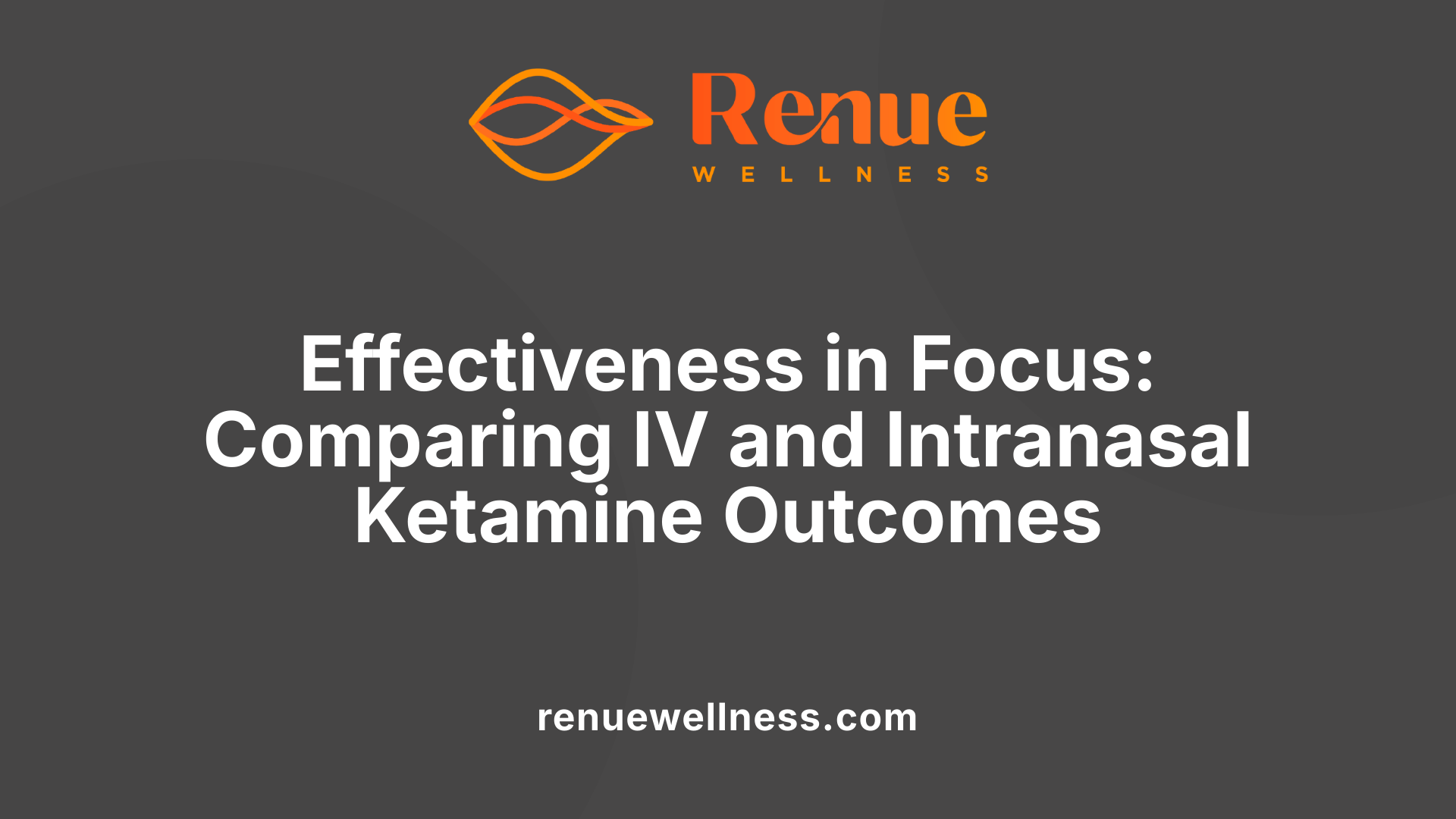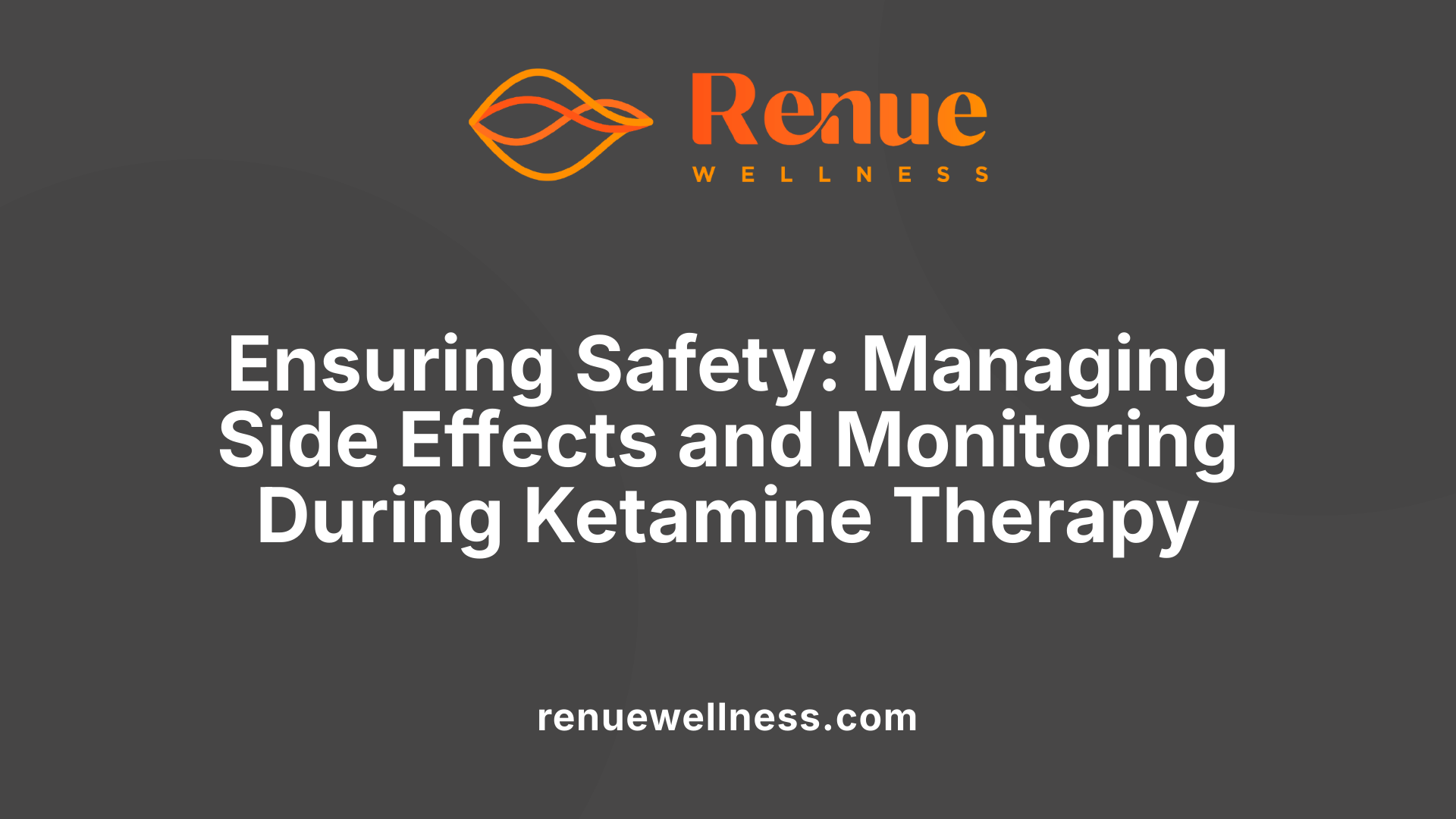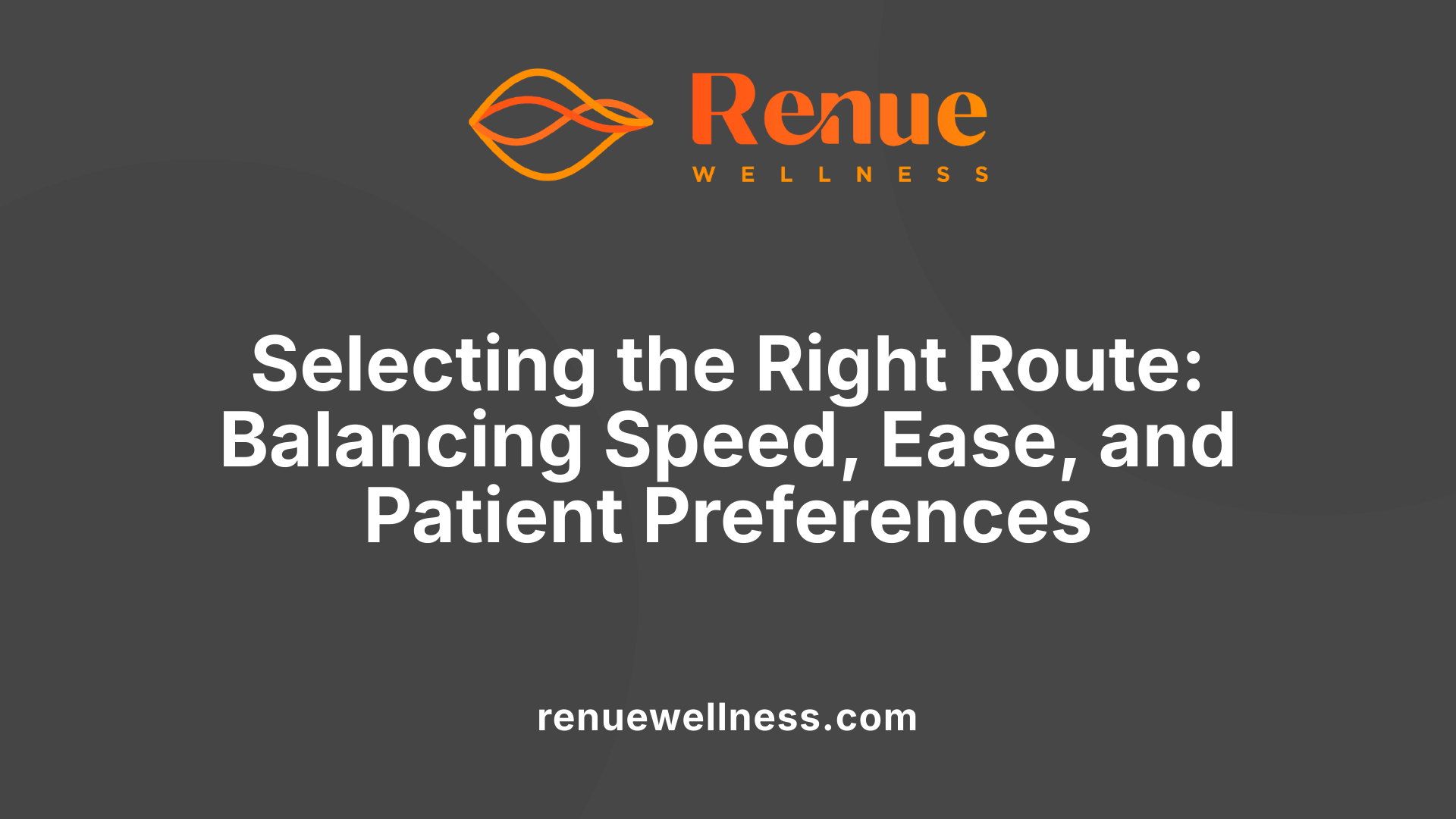The Difference Between IV Infusion and Intranasal Ketamine


August 5, 2025
Understanding the Two Main Ketamine Treatment Modalities
Ketamine has emerged as a groundbreaking treatment for severe depression, especially treatment-resistant depression (TRD). Among its various administration routes, intravenous (IV) infusion and intranasal spray are the most prevalent and studied. This article delves into the differences between these two methods, covering their mechanisms, efficacy, safety profiles, and the factors influencing treatment choices, to help patients and clinicians make informed decisions.
Method of Administration and Pharmacokinetics

How does each route administer ketamine?
Ketamine can be delivered via several routes, including intravenous (IV), intranasal, intramuscular (IM), oral, and buccal. The most studied and effective method for treatment-resistant depression is IV infusion, where the drug is delivered directly into the bloodstream using a catheter over 40 to 60 minutes. This method allows for precise control over the dose and immediate adjustment if side effects occur.
Intranasal ketamine, often marketed as esketamine (Spravato), involves spraying a specific dose into the nasal passages using an atomizer under medical supervision. This route is less invasive, more convenient, and suitable for outpatient settings.
Intramuscular administration involves injecting ketamine into a muscle, which has less predictable absorption and cannot be halted once injected. Oral ketamine, taken as lozenges or liquid, is absorbed through the mucous membranes of the mouth and stomach, but with significantly lower and more variable blood levels.
Overall, IV provides rapid, controlled delivery, while intranasal offers convenience with moderate onset times.
What are the bioavailability levels of different delivery routes?
Bioavailability measures the portion of the drug that reaches systemic circulation from the administered dose.
| Route | Bioavailability | Description |
|---|---|---|
| IV infusion | 100% | All the administered dose reaches bloodstream directly |
| Intranasal | 45-50% | Approximately half of the dose passes into circulation |
| Intramuscular | 93% | High absorption, close to IV but slightly less efficient |
| Oral | 16-24% | Less absorbed, affected by digestion and first-pass effect |
| Buccal | 30-40% | Moderate absorption through oral mucosa |
IV infusion provides the highest bioavailability, making it the most effective in delivering the drug quickly. In contrast, intranasal and oral routes have lower bioavailability, which can affect the overall efficacy.
How do the onset of action and effectiveness compare between IV and intranasal routes?
IV ketamine offers an extremely rapid onset of action, often within 30 to 60 seconds due to direct entry into the bloodstream. Its effects can be felt immediately and tend to last longer, with therapeutic benefits persisting for days with structured treatment protocols.
Intranasal ketamine has a moderate onset, typically beginning to work within 5 to 15 minutes after administration. Patients often notice some relief within 40 minutes. Despite the slightly delayed onset compared to IV, intranasal delivery still produces rapid improvements in depressive symptoms.
In terms of effectiveness, studies indicate that IV ketamine has a higher response rate (around 70-80%) compared to intranasal esketamine (approximately 50%). Moreover, IV treatments tend to require fewer doses to reach remission, partly due to its superior bioavailability and rapid, controlled delivery.
In conclusion, IV ketamine rises ahead in speed and predictability, making it especially suitable for urgent cases. Meanwhile, intranasal ketamine offers a helpful balance of efficacy and convenience, fitting well for outpatient care.
| Parameter | IV Ketamine | Intranasal Ketamine |
|---|---|---|
| Bioavailability | 100% | 45-50% |
| Onset of action | Immediate (within seconds to 1 min) | 5-15 minutes |
| Duration of effects | Up to several days with repeat doses | Up to two weeks, with repeated doses |
| Response rate (approximate) | 70-80% | 50% |
| Safety and control | Highest (full control over dosing) | Moderate control; less precise |
Both routes are effective, but their pharmacokinetic profiles influence their application in clinical settings.
Efficacy and Clinical Effectiveness

How do the efficacy and effectiveness of IV infusion compare to intranasal ketamine for mental health treatments?
Recent research indicates that intravenous (IV) ketamine and intranasal esketamine are similarly effective in treating treatment-resistant depression (TRD). Both methods have demonstrated comparable response and remission rates in multiple studies, with rapid onset of antidepressant effects within hours of administration. However, IV ketamine often leads to faster remission times and can be more cost-efficient, especially in clinical settings.
Most side effects of both treatments include nausea, headaches, and panic attacks, with their safety closely monitored during and after treatment sessions. Meta-analyses suggest that increasing the esketamine dose enhances its efficacy, while higher doses of IV ketamine do not significantly improve response rates beyond the standard 0.5 mg/kg dose.
In terms of treatment response speed, IV ketamine generally acts faster, with effects sometimes lasting several days or longer, compared to nasal spray, which begins working within 10-15 minutes but may have shorter durations.
Critically, a current large-scale study funded by the Patient-Centered Outcomes Research Institute (PCORI) is directly comparing patient outcomes between IV ketamine and intranasal esketamine. Preliminary evidence points toward similar overall effectiveness, but with IV ketamine requiring fewer treatments to achieve remission, and potentially offering a more accessible option due to lower costs.
Are there scientific studies or clinical trials comparing the effectiveness of IV infusion and intranasal ketamine?
Yes, multiple scientific studies and ongoing clinical trials have evaluated the relative effectiveness of IV ketamine and intranasal esketamine for TRD. Controlled research, including meta-analyses and randomized trials, have consistently shown that both therapies significantly reduce depressive symptoms.
A notable systematic review compared response and remission rates, revealing that IV ketamine tends to have higher response rates—ranging from 70-80%—and faster time to remission compared to intranasal forms, which have response rates around 50-60%. Additionally, IV ketamine's bioavailability is 100%, enabling precise dosing and immediate adjustments.
Furthermore, an important aspect of ongoing research involves studying patient preferences, side effect profiles, and long-term outcomes. The current phase of research, such as the Yale-led study, aims to definitively establish whether IV ketamine’s faster action and lower treatment volume translate into superior clinical benefits over intranasal esketamine.
In summary, existing scientific data supports that IV ketamine and intranasal esketamine are effective options for TRD, with IV infusions showing slightly higher response rates and faster remission. Ongoing research continues to refine understanding of their comparative benefits, safety, and optimal application in clinical practice.
Safety, Side Effects, and Monitoring

What are the safety profiles and potential side effects associated with IV infusion and intranasal ketamine?
IV ketamine typically exhibits a rapid onset of side effects, which are usually mild and transient. Common reactions include dizziness, nausea, increased blood pressure, and dissociation—an altered state of perception or consciousness. These effects are monitored closely in hospital or clinical settings, allowing healthcare providers to adjust doses or halt treatment if necessary.
In contrast, intranasal ketamine and esketamine are associated with side effects such as nasal irritation, dizziness, dissociation, dry mouth, and cognitive disturbances like difficulty concentrating or confusion. These adverse effects tend to occur shortly after administration and often resolve within a few hours. Short-term studies indicate that intranasal formulations are generally well-tolerated, but some individuals experience psychotomimetic effects or challenges related to nasal delivery.
Both routes of administration carry inherent risks, but IV ketamine’s rapid onset allows for immediate management of side effects, whereas intranasal approaches require vigilant supervision to ensure safety. Overall, while short-term safety profiles are acceptable, long-term safety data are still limited.
How are side effects managed, and what safety protocols are in place?
Managing side effects from ketamine treatments involves meticulous monitoring of vital signs—heart rate, blood pressure, and mental status—during each session and afterward.
With IV ketamine infusions, administered in controlled medical environments, clinicians can immediately intervene by adjusting infusion rates or stopping treatment if adverse responses such as severe dissociation, blood pressure spikes, or allergic reactions occur. The ability to control the dosage precisely and observe the patient continuously enhances safety.
For intranasal ketamine, supervision by trained medical staff is crucial. Patients are typically observed for at least two hours following administration to promptly detect and manage side effects such as dizziness, dissociation, nausea, or changes in blood pressure.
Both methods prioritize adherence to safety protocols like pre-treatment screening, continuous vital sign monitoring, and post-treatment observation. These measures help mitigate risks associated with transient but intense adverse effects like dissociation or blood pressure increases.
While both forms of ketamine are generally considered safe in properly supervised settings, the potential for side effects necessitates strict safety protocols. These ensure that treatments are not only effective but also minimize the risk of complications, making ketamine therapy a viable option for suitable patients.
Choosing the Appropriate Treatment Route and Patient Considerations

What factors should be considered when choosing between IV infusion and intranasal ketamine treatments?
Selecting the most suitable ketamine treatment route involves analyzing several practical and clinical factors. Both IV infusion and intranasal esketamine demonstrate similar overall effectiveness, but their profiles differ significantly.
IV ketamine offers rapid onset and high bioavailability, with effects often beginning within minutes, making it ideal for urgent situations such as severe depression with suicidal ideation or acute treatment needs. It allows precise control over dosage during infusion, and healthcare providers can adjust the administration in real-time. These qualities make IV therapy especially effective in emergency or highly resistant cases, typically requiring fewer sessions to achieve remission.
In contrast, intranasal esketamine provides a more convenient, outpatient-friendly administration with a moderate onset of about 5-15 minutes. Its non-invasive nature appeals to patients wary of needles and those receiving treatment in less acute settings. While easy to use, the absorption rates vary (around 25-50%), leading to less predictable drug levels. This variability can influence response duration and intensity.
Clinical circumstances, patient health status, and preferences are critical in guiding the route choice. For example, patients with difficulty accessing IV therapy, or those preferring less invasive options, might favor nasal spray. Conversely, patients needing rapid relief or in urgent mental health crises may benefit more from IV infusions.
What are the safety and patient preference considerations?
Safety profiles are essential in decision-making. IV ketamine, administered under medical supervision, allows immediate management of potential side effects like dissociation, nausea, or blood pressure spikes. The controlled setting minimizes risks such as overdose or adverse reactions since providers can slow, pause, or stop infusions as needed.
Intranasal esketamine, while generally safe, can cause nasal discomfort, dizziness, or dissociation, with side effects typically milder than those of IV treatments. Because it's administered outside a hospital environment initially, some increased vigilance in side effect management is necessary.
Patient preferences also influence choices. Needle-phobic individuals may prefer the non-invasive nasal spray. Conversely, those needing rapid, more predictable responses may opt for IV administration. Safety considerations, such as the ability to monitor in a controlled setting, are pivotal in high-risk cases.
What are the financial and insurance implications of each method?
From a financial standpoint, intranasal esketamine (Spravato) benefits from FDA approval and widespread insurance coverage, making it more accessible to many patients. The cost per dose ranges from approximately $951 to $1,353, but insurance plans, including Medicare and Medicaid, often cover the treatment, reducing out-of-pocket costs.
On the other hand, IV ketamine treatments are typically off-label for depression and are not consistently covered by insurance, resulting in out-of-pocket expenses that can average around $187 per treatment under Medicare. Despite the higher personal cost, IV ketamine is substantially less expensive per session and often requires fewer treatments to achieve remission.
Patients should engage with healthcare providers and insurers to explore coverage options. Some clinics may offer financial assistance programs or sliding-scale fees for IV treatments. Ultimately, treatment choice may involve balancing financial affordability with clinical needs and patient comfort.
| Aspect | IV Ketamine | Intranasal Esketamine | Additional Notes |
|---|---|---|---|
| Delivery Method | Intravenous infusion | Nasal spray | IV allows precise dosing, nasal is less invasive |
| Bioavailability | 100% | 25-50% | Biochemistry affects effectiveness |
| Onset of Effects | Immediate (30-60 sec) | 5-15 min | Speed influences treatment suitability |
| Cost per Treatment | Approximately $187 (Medicare) | $951-$1353 | Insurance coverage varies |
| Safety Determinants | Monitored in clinical setting | Supervised at certified clinics | Safety management is crucial |
| Patient Preference | Needle-based, rapid relief | Non-invasive, outpatient | Preference influences adherence |
| Typical Treatment Schedule | 5-6 infusions over 3 weeks | Biweekly for 4 weeks, then weekly | Protocols differ based on severity |
| FDA Approval | Off-label for depression | Approved for depression | Regulatory status affects coverage |
Understanding these factors can help clinicians and patients make well-informed choices aligned with clinical needs, personal preferences, and financial circumstances, leading to better treatment adherence and outcomes.
Making an Informed Choice for Mental Health Treatment
Both IV infusion and intranasal ketamine have proven effective in rapidly alleviating symptoms of treatment-resistant depression, with differences that can influence patient choice. IV ketamine offers faster onset, higher bioavailability, and a more controlled treatment environment, making it suitable for severe cases requiring immediate intervention. On the other hand, intranasal esketamine provides a less invasive, more convenient outpatient option, with FDA approval and broader insurance coverage, appealing to patients seeking easier access. The selection of a treatment route should consider efficacy, safety, cost, patient preferences, and clinical circumstances, emphasizing the importance of personalized care in mental health treatment. Ongoing research continues to refine understanding, ensuring that healthcare providers can tailor treatments to maximize benefits and minimize risks.
References
- Study: Intravenous Ketamine Vs. Intranasal Esketamine
- The Differences Between Nasal Ketamine and Ketamine Infusion
- Comparative Effectiveness of Intravenous Ketamine and Intranasal ...
- Ketamine Infusion, Injection, Nasal Spray, or Oral Lozenge
- IV vs. Oral Ketamine: Why Route Matters | Principium in NYC
- Intravenous vs intranasal ketamine — Is there a difference?
- Yale-Led Study Will Compare Effectiveness of IV Ketamine and ...
- Is Intravenous Ketamine Better Than Intranasal Esketamine for ...
- Intranasal Ketamine vs. Ketamine Infusions - Propel Therapeutics
Recent Posts
Conditions Treated
AnxietyDepressionOCDPTSDPostpartum DepressionPain ManagementSubstance AbuseSuicidal IdeationOur Location


